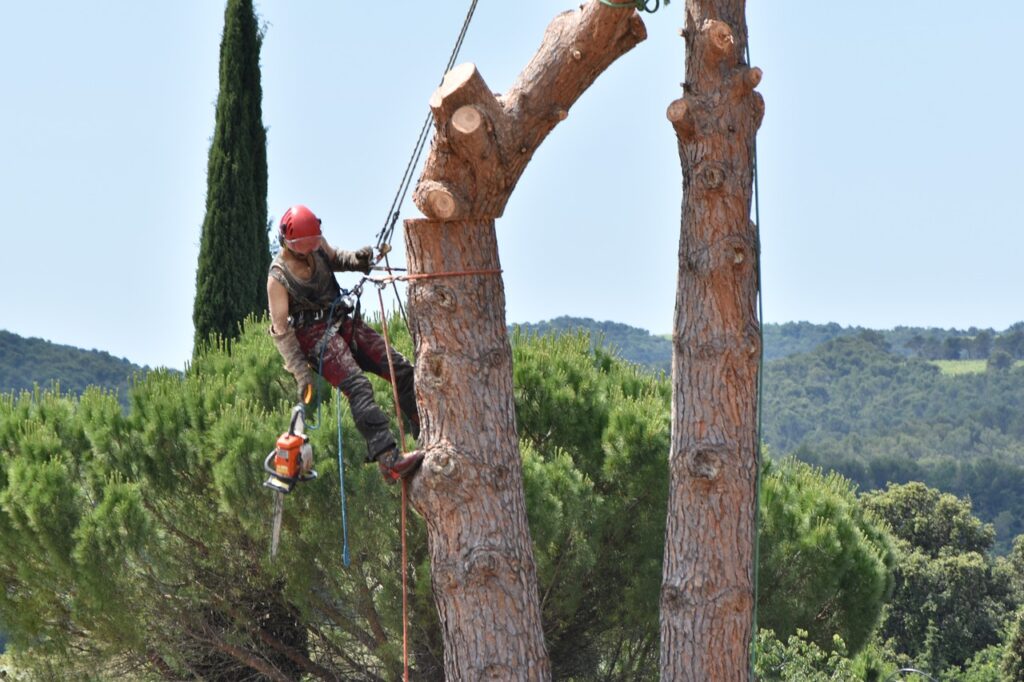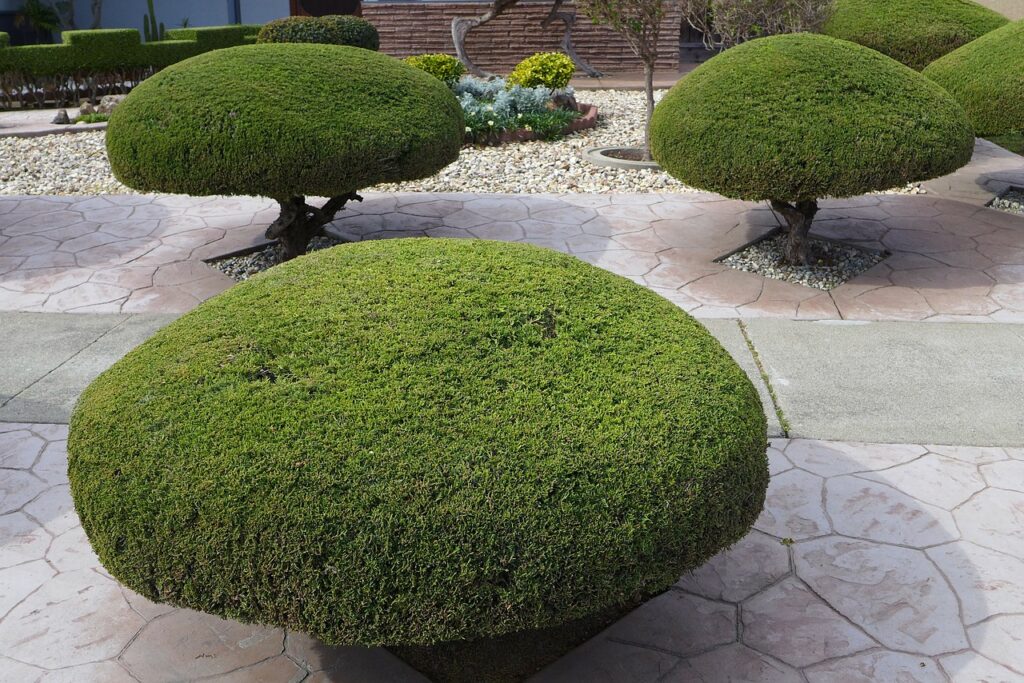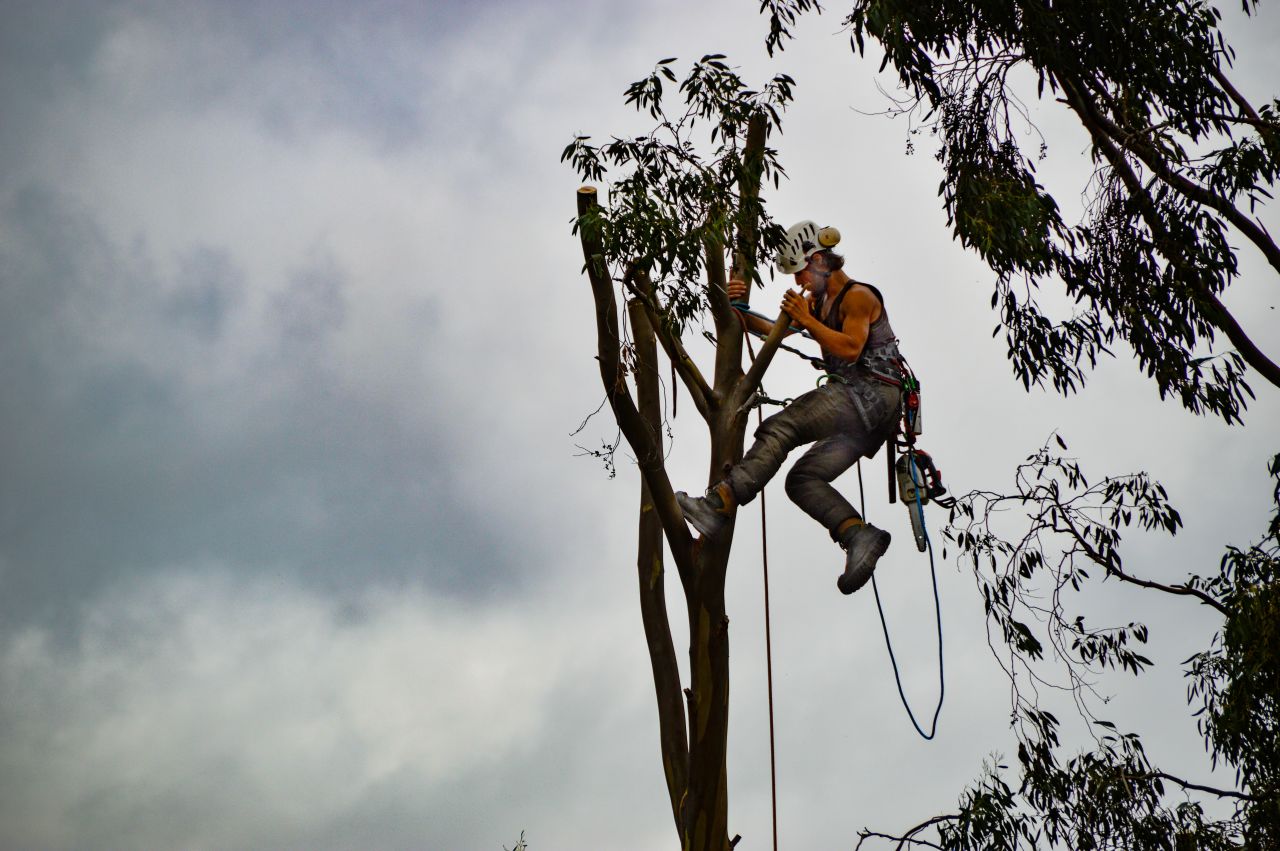The trees in the forest can do whatever they choose. They can extend their limbs as far as they will go, develop their branches as far as they can, and then let their ageing, feeble one's plummet to the ground below. We shouldn't give the trees in our yards and on our streets as much leeway. Our trees need to grow robust without becoming a hazard, yet we still want them to have a natural appearance.
What are the benefits of tree cutting and pruning? Numerous species of birds, squirrels, and other wildlife use trees as decoration in our yards and around our houses. The trees in our lives represent expansion and vitality, bringing us serenity, comfort, shade, and protection. Trees are beautiful, and the creatures who call them home deserve our best efforts to keep them that way. Even though tree trimming may not seem like a big deal, it actually plays a crucial role in keeping trees healthy.
Tree trimming is classified into four types:
- Fine Pruning: The process of thinning a tree by removing smaller branches.
- Standard Pruning: Heavy pruning to strengthen the tree's limbs.
- Hazard Trimming: For hazardous trees. The standard procedure calls for the cutting down of any branches with a diameter of two inches or more.
- Crown Reduction Trimming: Large branches should only be pruned back or removed if there has been considerable storm damage, dieback, or the branches are interfering with electricity lines. No more than a third of the tree's crown should be cut away in these situations.
Reasons To Hire An Arborist For Tree Pruning Assistance
Having trees around is beneficial to the environment and the health of the community. But just like our own bodies, trees need regular care if they are to provide us with any lasting benefits. The correct people with the right skills and tools are essential for effective maintenance. The tree and the inexperienced worker both run the danger of harm if things don't go as planned. Many businesses provide this service. As arborists, they have received extensive training to meet your specific tree care needs.
Considering the difficulties they confront on a daily basis, arborists in Sydney, Australia, are highly trained specialists who understand what it takes to properly care for a tree. They are well-versed in the art and science of tree pruning and know just what to do.
The Benefits of Hiring Arborists
It's recommended that those in need of Tree Pruning Sydney seek the services of experienced and trained arborists. They offer a variety of tree services, including planting, evaluation, removal, pruning, expert guidance, and emergency tree care, all of which can help you get the most out of your tree investment at the lowest possible cost.
These trained professionals are masters at pruning trees to ensure their continued health, beauty, and protection from pests and rodents. There are numerous causes for trees to be trimmed. To begin, young trees require regular pruning so that they can strengthen their framework. Pruning allows more light and air to pass through the canopy, improving comfort in shady areas.
Moreover, by pruning, you can improve the tree's structure and lessen the likelihood of harm from storms and rain. Even with a damaged tree, you can improve the aesthetics by removing dead wood from the branch tips.
Planting
Contacting an arborist is recommended if you intend to plant a large number of trees, as they will know where to best situate each species. When you hire a professional, they can also advise you on how to plant trees correctly to ensure their health and growth. A plant might not grow at all if it is planted in the wrong spot. When it comes to water and light, different plants have different requirements.
Some trees may require more room to expand, while others could benefit from being shielded from pests and illnesses. Plant growth may be stunted or even prevented entirely if certain conditions aren't met from the get-go. Only an experienced arborist has the knowledge and training to plant trees on a huge scale.
Health Care
A healthy tree with a solid foundation is maintained by regular care and inspections. Particularly in metropolitan contexts, which are more polluted and, consequently, more stressful on trees, well-maintained trees are stronger and more immune to insect attacks, illnesses, and external challenges like site conditions. Branches and trees need regular care, including assessments of health and safety, a spray or injection programme to ward off pests and diseases, adequate airflow to promote root growth, capping or bracing to strengthen brittle branches, timely irrigation and fertiliser, and regular trimming.
Emergency Tree Services
There will always be unavoidable circumstances, no matter how well we plan for them or how often we perform maintenance and repairs. In the event of a natural disaster, such as a hurricane or an earthquake, weaker branches or even entire trees may fall and inflict damage to nearby structures, vehicles, or even people. Trimming or removing a tree without the assistance of an arborist who provides tree service may be a time-consuming and dangerous endeavour, and it can also put people and property in peril.
When dealing with trees and limbs that have been entangled in power lines or other structures as a result of a storm, rain, or other unforeseen catastrophe, extreme caution must be exercised. Because trees are good conductors of electricity, anyone who comes into contact with live wires should exercise extreme caution. If power lines are down, contact your local utility company immediately.
Removal
Tree felling should only be done in extreme cases when all other options have been exhausted. Professional Tree Risk Assessments are often performed by Certified Arborists (TRAQ). Only after these specially trained individuals have evaluated the situation and provided relief measures, including removal, will we be able to make a decision. In the event that removal is the only viable choice, arborists are trained and equipped to do so safely and effectively.
When a tree is rotting or dead, when it is posing an irreversible hazard, when it has a bad impact on surrounding trees, or when it is able to be replaced by a more suitable choice, arborists may recommend removing it. When a tree is in the way of a building or other structure, it is sometimes cut down.

Ten Questions To Ask Before Hiring An Arborist
Some tree maintenance tasks are either too vast, too dangerous, or require specialised knowledge to complete safely and effectively. If you can't work with both feet firmly planted on the ground, it's probably best to call in the experts at a tree service. There are several potential hazards when working at a great height, including electrical wires, wildlife, surrounding fences, buildings, and residences, and so on. There is always a chance of something going wrong when you employ a professional tree service. You need to make sure you understand and agree with the answers your tree care professional gives you to these crucial questions to receive your money's worth and safeguard your interests.
- Will they give you a copy of their employment agreement in addition to their current insurance documents? This is the most vital query you can ask. You need to check their insurance to be sure you won't be responsible for any injuries, property damage, or other mishaps that may occur.
- Where do their credentials lie? Ideally, you should choose the services of a company that either has or employs a Certified Tree Care Safety Professional, is an Accredited Business with the Tree Care Industry Association (TCIA), or is certified by the International Society of Arboriculture (ISA) (CTSP). Will they be performing their duties near live wires? They will need to be Accredited Line Clearance Arborists if so.
- When asked, can they supply contact information for previous clients? Any reputable business worth its salt will gladly provide references upon request. You don't want to hear about old clients, so make sure you ask for references from within the last month or so.
- Can you get an in-depth quote from them? To answer the following question, you should get written estimates from three comparable organisations to compare costs and comprehend the project's scope.
- What methods and tools will be used to complete this task? You wouldn't want to risk unnecessary harm to your grass and flowerbeds by having heavy machinery driven over the area. Make sure they are aware of the position of sprinkler heads and other potential hazards if they must cross your property. If they do damage, what is their policy, and do you agree with it? Before beginning any work, it could be helpful to take pictures of the area to use as evidence in the event of damage. Ask about their plans for trash removal both during and after the job is done.
- To what extent will this delay the project? Therefore, it is helpful to receive an estimate. It's possible that one firm estimates three days while another estimates three hour.
- How expert does the business come across? Please describe the company truck. Has it been given the attention it needs? Does it seem like a well-maintained truck? Do you really want them to care for your tree and property if they can't even keep their own tools in working order? Does this company have an online presence? Design and content, as well as the condition of the cars they use for work, might give you an idea of how professional they are. That can provide insight into the company's operations.
- Do they climb trees with spikes in order to prune them? You should insist that they not utilise spikes, which can lead to harmful wounds, unless you plan on having the trees removed.
- Do they promote topping, wherein the tops of live trees are cut off? It's another sign that you should keep looking if you find yourself doing this, especially among mature, healthy hardwood trees.
- When working on your property, will the crew members wear safety gear such as hard hats and gloves? For any tree care task, it is imperative that appropriate PPE be worn in accordance with OSHA regulations. A reliable tree service will insist on safety gear for its employees.
Tree Trimming Dos And Don'ts You Should Know
Professional arborists and other tree care specialists should be consulted for services like tree pruning and hedge trimming. Tree trimming is useful for a variety of reasons, including removing diseased or dead branches and keeping the yard looking neat and tidy. However, if not done properly, the task can be quite risky. So that you know what to do and what not to do while pruning trees and plants, we have compiled a detailed list of guidelines.
General Tree And Hedge Trimming Do's And Don'ts
- Check the trees after a storm or period of high winds to see if they need to be trimmed to remove any dead or damaged branches.
- To keep your trees healthy, you should familiarise yourself with proper pruning techniques.
- Pruning overgrown trees and shrubs can prevent damage to your roof and home.
- Additionally, pruning promotes fruit and blossom development.
- Remove any dead or decaying branches that could fall on your home, electrical lines, or family members.
- It's not good for a tree's health to lose more than 25–30% of its leaves all at once.
- Just when you think you need to do some pruning, stop.
- It's not worth risking the tree's health for the sake of aesthetics if you prune a young tree. Only remove broken or dead branches from a young tree.
- After you're done trimming a tree, don't use a sealant on the cuts to prevent decay.
Dos And Don'ts Of Tree Trimming For Maximum Safety
- Protect yourself against harm by wearing long pants, gloves, and safety glasses.
- Trim the outer branches as needed.
- Try not to scale a tree without ropes and other safety equipment.
- Trees within 10–12 feet of a transformer or power line should not have their interior foliage trimmed down too much or be pruned near the trunk.
- Try not to use a chainsaw on branches that are too high up to reach safely.
When To Prune Trees: Dos And Don'ts
- Pruning in the fall is not recommended unless you find unhealthy or dead branches, as this is when mending is slowest.
- Trees and hedges benefit from being pruned in the late winter or early spring to encourage new growth in the spring.
- If you see that a tree is growing too quickly due to damage or illness, you can aid by cutting back its branches in the summer.
- Avoid tree pruning in the spring until after the flowers have fully bloomed.
Conclusion
Pruning trees may not seem like much, but it's important for their continued health. Sydney, Australia, is home to some of the world's best tree care experts. For maintenance to be successful, the right person must have access to the appropriate resources. They do emergency tree care, routine and preventative maintenance, planting, assessing, removing, pruning, and guiding clients. Light and air can circulate freely through a tree's canopy after it has been pruned, making shaded areas more pleasant.
When other solutions have been thoroughly explored and rejected, tree removal should be reserved as an absolute last resort. Certified Arborists are the go-to guys for professional tree risk assessments. In case of an accident, injury, or property loss, you want to know that you won't be held liable. Working near live wires, they should also be Accredited Line Clearance Arborists. It would be best to look for a firm that either has or employs a Certified Tree Care Safety Professional (CCSP) from the Tree Care Industry Association (TCIA). Tree trimming serves multiple purposes, including eliminating hazardous branches and maintaining a clean and orderly yard.
The job is really dangerous if not done correctly. Here is a list of dos and don'ts for trimming shrubs and trees. Besides removing diseased or dead branches, there are better times to prune than autumn. When pruning a tree within 10–12 feet of a transformer or power line, avoid cutting back the leaves too close to the trunk and any branches that could touch the wires.
Content Summary
- We should give the trees in our yards and streets less leeway.
- Even though tree trimming may not seem like a big deal, it plays a crucial role in keeping trees healthy.
- Having trees around benefits the environment and the community's health.
- But just like our own bodies, trees need regular care to provide us with lasting benefits.
- The correct people with the right skills and tools are essential for effective maintenance.
- As arborists, they have received extensive training to meet your specific tree care needs.
- They offer various tree services, including planting, evaluation, removal, pruning, expert guidance, and emergency tree care, all of which can help you get the most out of your tree investment at the lowest possible cost.
- Contacting an arborist is recommended if you plan to plant many trees, as they will know where to situate each species best.
- When you hire a professional, they can also advise you on planting trees correctly to ensure their health and growth.
- Only an experienced arborist has the knowledge and training to plant trees on a huge scale.
- Trimming or removing a tree without the assistance of an arborist who provides tree service may be time-consuming and dangerous. It can also put people and property in peril.
- If removal is the only viable choice, arborists are trained and equipped to do so safely and effectively.
- If you can't work with both feet firmly planted on the ground, it's best to call in the experts at a tree service.
- When you employ a professional tree service, there is always a chance of something going wrong.
- You must ensure you understand and agree with the answers your tree care professional gives you to these crucial questions to receive your money's worth and safeguard your interests.
- Ideally, you should choose the services of a company that either has or employs a Certified Tree Care Safety Professional, is an Accredited Business with the Tree Care Industry Association (TCIA), or is certified by the International Society of Arboriculture (ISA) (CTSP).
- You don't want to hear about old clients, so ask for references from within the last month or so.
- To answer the following question, you should get written estimates from three comparable organisations to compare costs and comprehend the project's scope.
- Before beginning any work, take pictures of the area to use as evidence in the event of damage.
- Ask about their plans for trash removal both during and after the job is done.
- Design and content, as well as the condition of the cars they use for work, might give you an idea of how professional they are.
- A reliable tree service will insist on safety gear for its employees.
- Professional arborists and other tree care specialists should be consulted for services like tree pruning and hedge trimming.
- So that you know what to do and what not to do while pruning trees and plants, we have compiled a detailed list of guidelines.
- To keep your trees healthy, you should familiarise yourself with proper pruning techniques.
- It's not good for a tree's health to lose more than 25–30% of its leaves all at once.
- It's not worth risking the tree's health for aesthetics if you prune a young tree.
- Only remove broken or dead branches from a young tree.
- After trimming a tree, don't use a sealant on the cuts to prevent decay.
- Trim the outer branches as needed.
- Pruning in the fall is only recommended if you find unhealthy or dead branches, as this is when mending is slowest.
- Trees and hedges benefit from being pruned in the late winter or early spring to encourage new growth in the spring.
- Avoid tree pruning in the spring until after the flowers have fully bloomed.
Frequently Asked Questions About Tree
- Maintain Plant Health and Aesthetics.
- Control Growth.
- Encourage Flower and Fruit Production.
- Create Special Forms.
- Rejuvenate Old or Overgrown Plants.
- Protect People and Property.
The process of removing branches from a tree in a planned and chosen manner is known as pruning. The objective is to prune away any unneeded branches, strengthen the tree's overall structure, and encourage new, healthy growth.
The Top Five Benefits of Tree Pruning
- Health: Tree pruning maintains a tree's health.
- Appearance: Pruning improves a tree's appearance.
- Sunlight: Tree pruning allows adjacent plants adequate sunlight.
- Reduce Risks: Tree pruning reduces the chances of accidents happening.
- Shape: Tree pruning helps to shape young trees.
Trees reduce the 'Greenhouse' effect by removing carbon dioxide from the air and releasing oxygen. Each year a mature tree produces enough oxygen for ten people. Trees are also an effective sound barrier and can limit noise pollution. Recent research shows that trees also help reduce the stress of modern life.
Pruning Effects on Tree Physiology
Removing branches has at least three consequences on the physiology of a tree: it reduces the tree's ability to capture energy, depletes the tree's stored energy reserves, and affects the tree's development pattern.



